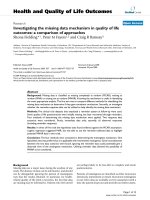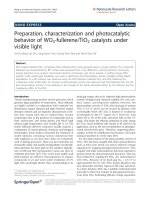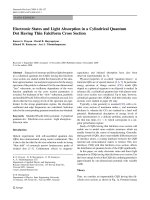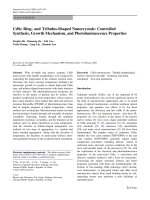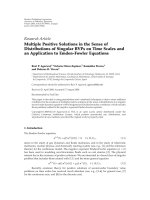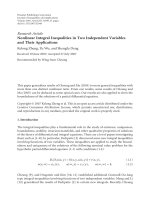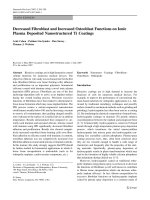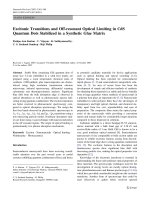Báo cáo hóa học: " Electron States and Light Absorption in Strongly Oblate and Strongly Prolate Ellipsoidal Quantum Dots in Presence of Electrical and Magnetic Fields" pot
Bạn đang xem bản rút gọn của tài liệu. Xem và tải ngay bản đầy đủ của tài liệu tại đây (373.91 KB, 8 trang )
NANO EXPRESS
Electron States and Light Absorption in Strongly Oblate
and Strongly Prolate Ellipsoidal Quantum Dots in Presence
of Electrical and Magnetic Fields
Karen G. Dvoyan Æ David B. Hayrapetyan Æ
Eduard M. Kazaryan Æ Ani A. Tshantshapanyan
Received: 17 May 2007 / Accepted: 18 July 2007 / Published online: 13 November 2007
Ó to the authors 2007
Abstract In framework of the adiabatic approximation
the energy states of electron as well as direct light
absorption are investigated in strongly oblate and strongly
prolate ellipsoidal quantum dots (QDs) at presence of
electric and magnetic fields. Analytical expressions for
particle energy spectrum are obtained. The dependence of
energy levels’ configuration on QD geometrical parameters
and field intensities is analytically obtained. The energy
levels of electrons are shown to be equidistant both for
strongly oblate and prolate QDs. The effect of the external
fields on direct light absorption of a QD was investigated.
The dependence of the absorption edge on geometrical
parameters of QDs and intensities of the electric and
magnetic fields is obtained. Selection rules are obtained at
presence as well as absence of external electric and mag-
netic fields. In particular, it is shown that the presence of
the electric field cancels the quantum numbers selection
rules at the field direction, whereas in radial direction the
selection rules are preserved. Perspectives of practical
applications for device manufacturing based on ellipsoidal
quantum dots are outlined.
Keywords Ellipsoidal quantum dot Á
Electric and magnetic field
Introduction
Recent interest to semiconductor quantum dots (QDs) is
conditioned by new physical properties of these zero-
dimensional objects, which are conditioned by
size-quantization (SQ) effect of the charge carriers (CCs)
[1–3]. Such new structures were obtained by means of
interrupted growth of QDs within semiconductor media.
Development of new growth technologies, in particular
such as Stranski-Krastanov epitaxial method, made pos-
sible development of QDs having various shapes and
dimensions. It is known that energy spectrum of CCs of
a QD is fully quantized and similar to the energy spectra
of atoms, in view of that the QDs are often called
‘‘artificial atoms’’ [4]. Most of the research in this area is
focused on studies of the spherical QDs. However during
last years the ellipsoidal, pyramidal, cylindrical and lens-
shaped QDs are also undergoing theoretical and experi-
mental investigations [5–10]. Due to presence of strong
SQ effect in the mentioned objects the physical charac-
teristics of CCs in such systems strongly depend on the
geometrical shapes of QDs. Even slight variation of the
shapes significantly affects the CC spectrum [11, 12]. In
other words, QD geometric shapes and dimensions may
serve as useful tools for CC energy spectrum and other
characteristic parameters variation inside a QD for vari-
ous practical applications in systems comprised of QD
ensembles. Monitored ‘shaping’ during the process of
growth makes possible simulation and development of
samples with desired physical parameters.
Another powerful factor affecting the CC energy
spectrum shaping inside QD is the confinement potential
of the QD—Media Interface front of the growth. The
semiconductor nanostructures based on GaAs/Ga
1Àx
Al
x
As-type systems are objects of intensive recent
K. G. Dvoyan (&) Á D. B. Hayrapetyan Á
E. M. Kazaryan Á A. A. Tshantshapanyan
Department of Applied Physics and Engineering,
Russian-Armenian State University, 123 Hovsep Emin Str.,
Yerevan 0051, Armenia
e-mail: ;
123
Nanoscale Res Lett (2007) 2:601–608
DOI 10.1007/s11671-007-9079-z
investigations due to wide band gap and availability of
well elaborated growth techniques of various systems
incorporating such materials. As a result of natural
diffusion process during the growth of QDs, the corre-
spondently forming confinement potential is such that can
be easily approximated in most cases by a parabolic
potential. Also note, that for this approximation the Kohn
theorem is well generalized, this proves that such
approximation is correct, the experimental verification is
provided in Ref. [13]. However, the effective parabolic
potential may origin due to peculiarity of the QDs shape
[14]. Such realization is possible for strongly oblate
(or prolate) QDs shape. Besides, the rotational ellipsoids,
or spheroids, in contrary to spheres, are known to be
described by two parameters (short and large half-axes
instead of radius). In addition to that the external electric
and magnetic fields causing quantization are alternative
tools of control of the energy spectrum of QDs CC. The
strong external fields, at certain values of their intensities,
may have the same, or even stronger SQ effect on the
energy spectrum than the quantum dot’s shape variation.
Note, that the magnetic field affects the CC motion only
in transversal direction, in difference to the electrical
field. Therefore two fields directed in parallel open pos-
sibility for a broad manipulation of the CC characteristics
inside semiconductor SQ systems.
In particular in paper [15] the quantum effect of the
magnetic field inside the of the strongly prolate QD is
investigated. The effect of electrical field on the CC
energy spectrum inside the mentioned system has been
considered in paper [10]. However, the combined effect
of unidirectional electric and magnetic fields is not
considered yet.
Analysis of the optical absorption spectra of various
semiconductor structures represents a powerful tool for
obtaining numerous characteristics of these structures,
namely: forbidden gap widths, effective masses of elec-
trons and holes, their mobility, dielectric features, etc.
Many papers study these spectra by experiments and
analysis, both in massive and SQ semiconductor structures
(see e.g. [16–18]). SQ phenomenon strongly affects the
character of absorption. Indeed, presence of new SQ energy
levels makes possible to realize new inter-band transitions
widening the scope of applications of devices based on
such systems. Meanwhile existence of the external quan-
tizing fields often results in restructuring of the energy
levels, as well as creation of new selection rules during the
process of the light absorption. Therefore electronic states
and direct inter-band light absorption are considered below
for strongly oblate ellipsoidal quantum dots (SOEQD) and
strongly prolate ellipsoidal quantum dots (SPEQD) at
presence of unidirectional electric and magnetic fields; the
problem is considered for strong SQ regime.
Theory
SOEQD Case: Electronic States Inside the Strongly
Oblate Ellipsoidal Quantum Dot in the Presence
of Unidirectional Electric and Magnetic Fields
Let us to consider an impenetrable SOEQD located in
unidirectional electric and magnetic fields (see Fig. 1a).
The potential energy of a charged particle (electron, or
hole) in such structure has the following form:
UðX; Y; ZÞ¼
0;
X
2
þ Y
2
a
2
1
þ
Z
2
c
2
1
1
; a
1
) c
1
;
1;
X
2
þ Y
2
a
2
1
þ
Z
2
c
2
1
[ 1
8
>
>
>
>
>
>
<
>
>
>
>
>
>
:
ð1Þ
where a
1
and c
1
are the short and long semiaxes of SPEQD,
respectively.
As is known, in the strong SQ regime, the energy of
Coulomb interaction between electron and hole can be
considered much smaller than the energy created by the
SOEQD walls. In the framework of such approximation,
one can neglect the electron–hole interaction energy. Thus,
the problem is reduced to analytical determination of the
energy separate expressions for electron and hole (as for
non-interacting particles). The quantum dot shape indicates
that particle motion along the Z-axis takes place faster than
in the normal direction, this also allows to utilize adiabatic
approximation. The system Hamiltonian under these
conditions has the following form:
H ¼
1
2l
P
~
þ
e
s
A
~
À eF
~
r
~
þ UðX; Y; ZÞ; ð2Þ
in which P
~
is the particle momentum operator, A
~
is the
vector potential of the magnetic field, F
~
is the electrical
field intensity, r
~
is the radius-vector, s is the light velocity
in vacuum, and e is the magnitude of electron charge.
Assuming the calibration of vector potential in cylindrical
coordinates to have a form A
q
¼ 0; A
u
¼
1
2
Hq; A
z
¼ 0 , one
can express the system Hamiltonian as
x
z
y
F H
b)
a)
Fig. 1 (a) Strongly oblate ellipsoidal quantum dot. (b) Strongly
prolate ellipsoidal quantum dot
602 Nanoscale Res Lett (2007) 2:601–608
123
H ¼À
"h
2
2l
o
2
oq
2
þ
1
q
o
oq
þ
1
q
2
o
2
ou
2
þ
o
2
oZ
2
À i
"hx
H
2
o
ou
þ
lx
2
H
8
q
2
À eFZ þ Uðq; u; ZÞ; ð3Þ
which may be represented as a sum of two Hamiltonians of
‘‘fast’’ H
1
and ‘‘slow’’ H
2
subsystems in dimensionless
variables:
H ¼ H
1
þ H
2
þ Uðr; u; zÞ; ð4Þ
where
H
1
¼À
o
2
oz
2
À f z; ð5Þ
H
2
¼À
o
2
or
2
þ
1
r
o
or
þ
1
r
2
o
2
ou
2
À ic
o
ou
þ
1
4
c
2
r
2
; ð6Þ
with assumed notations: r ¼
q
a
B
; z ¼
Z
a
B
; H ¼
H
E
R
; x
H
¼
eH
ls
;
f ¼
2leFa
3
B
"h
2
¼
eFa
B
E
R
; c ¼
"hx
H
2E
R
; where l is the effective mass of
electron, E
R
¼
"h
2
2la
2
B
is effective Rydberg energy, a
B
¼
j"h
2
le
2
is
the effective Bohr radius of electron, and j is the dielectric
permeability. The homogenous electrical and magnetic
fields are given by relations F
~
¼ F
~
ð0; 0; FÞ and
H
~
¼ H
~
ð0; 0; HÞ: Here we assume the wave function
(WF) to have the following form:
wðr; u; zÞ¼e
imu
vðz; rÞRðrÞ: ð7Þ
Following the above-mentioned adiabatic approxi-
mation, when the coordinate r of the ‘‘slow’’ subsystem
is fixed, the particle motion is localized in one-
dimensional potential well having effective width
LðrÞ¼2c
ffiffiffiffiffiffiffiffiffiffiffiffiffiffiffiffiffiffiffi
1 Àr
2
=a
2
p
, where a = a
1
/a
B
and c = c
1
/a
B
.
The Schro
¨
dinger equation for the ‘‘fast’’ subsystem will
acquire the following form:
H
1
vðz; rÞ¼e
1
vðz; rÞ: ð8Þ
After a number of simple transformations and numerical
simulation, for the close-to-bottom energy levels of the
spectrum (when the particle is predominantly localized in
the region r ( a) one can obtain the following power
series expression with high degree of accuracy:
e
1
ðrÞ¼a
n
þ b
2
n
r
2
; n ¼ 1; 2; ; ð9Þ
where a
n
and b
n
parameters depend on the value of the
electrical field. The relation (9) represents an effective
potential which is incorporated in the ‘‘slow’’ system
Schro
¨
dinger equation
ðH
2
þ e
1
ðrÞÞe
imu
RðrÞ¼ee
imu
RðrÞ: ð10Þ
Thus by solving the Eq. 10), we shall obtain the ultimate
energy relation for the charged particle (electron, hole)
e ¼ a
n
þ cm þ
ffiffiffiffiffiffiffiffiffiffiffiffiffiffiffi
b
2
n
þ c
2
q
ðN þ1Þ; N ¼ 0; 1; ; ð11Þ
where N =2n
r
+|m|, n
r
and m are the radial and magnetic
quantum numbers, respectively.
SPEQD Case: Electronic States Inside a Strongly
Prolate Ellipsoidal Quantum Dot in the Presence
of Unidirectional Electric and Magnetic Fields
Now let us to consider an impenetrable SPEQD located in
the unidirectional electric and magnetic fields (see Fig. 1b).
For this case the potential energy of the charged particle
(electron, or hole) will have the form (1) under the con-
dition a
1
( c
1
, where a
1
and c
1
are the short and long
semiaxes of SPEQD, respectively. As in the SOEQD case,
in the strong SQ regime we neglect the Coulomb interac-
tion between the electron and hole. The shape of QD
depicted in the Fig. 1b makes possible the particle motion
in the radial plane to be faster than along the Z-axis, which
also allows to use adiabatic approximation just like in the
SOEQD case. Here the system Hamiltonian has the form
(4), where instead of Eqs. 5 and 6, for the SPEQD case we
have
H
1
¼À
o
2
or
2
þ
1
r
o
or
þ
1
r
2
o
2
ou
2
À ic
o
ou
þ
1
4
c
2
r
2
; ð12Þ
H
2
¼À
o
2
oz
2
À f z: ð13Þ
The homogenous electrical and magnetic fields are
represented as F
~
¼ F
~
ð0; 0; FÞ and H
~
¼ H
~
ð0; 0; HÞ just as
is in the previous case, while the vector potential is
A
q
¼ 0; A
u
¼
1
2
Hq; A
z
¼ 0 . For this case we assume the
WF to have a structure
wðr; u; zÞ¼e
imu
Rðr; zÞvðzÞ: ð14Þ
Following the above-mentioned adiabatic approxi-
mation, when the z coordinate of the ‘‘slow’’ subsystem
is fixed, the particle motion is localized in two-dimensional
potential well having effective width rðzÞ¼a
ffiffiffiffiffiffiffiffiffiffiffiffiffiffiffiffiffiffiffi
1 Àz
2
=c
2
p
:
The Schro
¨
dinger equation for the ‘‘fast’’ subsystem has
the form
Nanoscale Res Lett (2007) 2:601–608 603
123
H
1
e
imu
Rðr; zÞ¼e
1
ðzÞe
imu
Rðr; zÞ: ð15Þ
After number of transformations we shall obtain the
following energy expression e
1
(z) for the ‘‘fast’’ sub-
system
e
1
ðzÞ¼a
n
1
;n
2
þ b
2
n
2
z
2
; ð16Þ
where
a
n
1
n
2
¼ 2c n
1
jmjþm þ1
2
þ
4n
2
a
2
; b
n
2
¼
2
ffiffiffiffiffi
n
2
p
ac
; ð17Þ
while n
1
and n
2
are some numbers depending on the
magnetic field intensity. The expression (16) is an effective
potential being incorporated in the Schro
¨
dinger equation
for the ‘‘slow’’ subsystem
fH
2
þ e
1
ðzÞgvðzÞ¼evðzÞ: ð18Þ
Solution of the Eq. 18 gives the final energy expression for
the charged particle (electron, hole)
e ¼ a
n
1
;n
2
þ 2b
n
2
N þ
1
2
À
f
2
4b
2
n
2
; ð19Þ
Direct Inter-Band Light Absorption
Another notable issue of the problem is the direct inter-
band absorption of the light by SOEQD in the strong SQ
regime. In other words, the relation c ( {a
B
e
, a
B
h
} holds,
where a
B
e(h)
is the effective Bohr radius of electron
(or hole). We consider the case of a ‘‘heavy’’ hole, when
l
e
( l
h
, l
e
and l
h
are the effective masses of electron and
hole, respectively.
The absorption coefficient is given by the expression
[16]
K ¼ A
X
v;v
0
j
Z
W
e
v
W
h
v
0
dr
~
j
2
dð"hX À E
g
À E
e
v
À E
h
v
0
Þ; ð20Þ
where v and v
0
are sets of quantum numbers (QN) cor-
responding to the electron and heavy hole, E
g
is the
forbidden gap width in the bulk semiconductor, X is the
incident light frequency and A is a quantity proportional
to the square of matrix element in decomposition over
Bloch functions.
Numerical calculations were made for the QD from
GaAs, with parameters: l
e
= 0.067m
e
, l
e
= 0,12l
h
, E
R
=
5.275 meV, a
B
e
= 104 A
˚
, E
g
= 1.43 eV. Finally, for the
quantity K and for the absorption edge (AE) we have
obtained:
K ¼ A
X
m;n;N
I
nn
0
J
NN
0
d
Â
W À
~
E Àa
ðeÞ
n
À c
e
m À
ffiffiffiffiffiffiffiffiffiffiffiffiffiffiffiffiffiffiffiffiffiffiffiffiffiffiffiffiffiffiffiffiffiffiffiffiffiffi
b
ðeÞ2
n
þ c
2
e
ðN þ1ÞÀ
q
a
ðhÞ
n
0
;
Àc
h
m
0
À
ffiffiffiffiffiffiffiffiffiffiffiffiffiffiffiffiffiffiffiffiffiffiffiffiffiffiffiffiffiffiffiffiffiffiffiffi
b
ðhÞ2
n
0
þ c
2
h
ðN
0
þ 1Þ
q
ð21Þ
W
100
¼
~
E þa
ðeÞ
1
þ
ffiffiffiffiffiffiffiffiffiffiffiffiffiffiffiffiffiffi
b
ðeÞ2
1
þc
2
e
q
þa
ðhÞ
1
þ
ffiffiffiffiffiffiffiffiffiffiffiffiffiffiffiffiffiffi
b
ðhÞ2
1
þc
2
h
q
; ð22Þ
where W
100
¼
"hX
100
E
R
, while
~
E ¼
E
g
E
R
; I
nn
0
and J
NN
0
are certain
integral quantities.
Let us now to consider the selection rules in this case. In
the absence of the fields, the transitions between the levels
with QN N = N
0
, n = n
0
and m = Àm
0
are allowed. When
the external fields are present the transitions are possible in
all cases of magnetic quantization in the radial direction,
between the levels with magnetic QNs m = Àm
0
. Under
weak magnetic quantization, when a
H
) a
1
, where
a
H
¼
ffiffiffiffiffiffiffi
"h
lx
H
q
is magnetic length, transitions are allowed
between the levels with radial QNs n
r
= n
r
0
, and
thus between the oscillatory QNs N = N
0
. In the case when
a
H
* a
1
, the selection rules among the oscillatory QNs are
cancelled, which is a result of competition between size
and magnetic quantization. A magnetic field of extremely
high-intensity, for which a
H
( a
1
, restores the selection
rules between the oscillatory QNs. It should be also noted
that the selection rules in the direction of electrical field are
becoming obsolete.
Consider now a direct inter-band light absorption inside
SPEQDs in the strong SQ regime. The absorption coeffi-
cient is given by the relation (20). In this particular case for
the K and AE we obtained the following expressions
K ¼ A
X
m;n;N
I
nn
0
J
NN
0
d
Â
W À
~
E Àa
ðeÞ
n
1
;n
2
2b
ðeÞ
n
2
N þ
1
2
þ
f
2
4b
ðeÞ2
n
2
À a
n
0
1
;n
0
2
À 2b
ðhÞ
n
0
2
N
0
þ
1
2
þ
f
2
4b
ðhÞ2
n
0
2
!
; ð23Þ
W
100
¼
~
E þa
ðeÞ
n
1
;n
2
þ b
ðeÞ
n
2
À
f
2
4b
ðeÞ2
n
2
þ a
ðhÞ
n
0
1
;n
0
2
þ b
ðhÞ
n
0
2
À
f
2
4b
ðhÞ2
n
0
2
;
ð24Þ
respectively; where W
100
¼
"hX
100
E
R
, while
~
E ¼
E
g
E
R
, where I
nn
0
and J
NN
0
are certain integral quantities.
At absence of the fields at the SPEQD case, the transi-
tions between the QNs N = N
0
, n
r
= n
r
0
, and m = Àm
0
are
604 Nanoscale Res Lett (2007) 2:601–608
123
allowed. The application of the external fields to the
SPEQD the following alternations from the previous case
can be indicated. When the magnetic quantization is either
weak or moderate, i.e. when a
H
) a
1
or a
H
*a
1
(here a
1
is
the short half-axis), the selection rules in the radial direc-
tion are becoming completely obsolete. As a result of this,
the selection rules between the oscillatory QNs are also
eliminated. Meanwhile, transitions between the magnetic
QNs remain unchanged: m = Àm
0
. Note that in the hypo-
thetical case of extremely strong magnetic field (when
a
H
( a
1
) the selection rules for transitions between the
oscillatory QNs are completely restoring.
Discussion of Results
As one can infer from the obtained results, the CC energy
spectrum both of SOEQDs and SPEQDs is equidistant.
More correctly, each level of the ‘‘fast’’ subsystem has a
family of equidistant ‘‘slow’’ subsystem levels positioned
thereupon. The obtained result is valid only for the levels
close to the well bottom (or having low QN values), due to
the assumed adiabatic approximation.
Note that CC energy levels are equidistant in the
absence of external fields. However, the transition fre-
quency between the equidistant levels when the fields are
present is usually higher. For example, in the absence of
fields, when half-axes of SOEQD are a
1
= 2.5a
B
,
c
1
= 0.5a
B
, the transition frequency for the first equidistant
family is obtained equal to x ¼ 2:17 Á10
13
c
À1
;which falls
into the IR part of spectrum. With the same half-axes, but
in the presence of fields H =10T, F = 500 V/cm the
transition frequency is almost one-and-half times higher:
x ¼ 3039 Á10
13
c
À1
. The only exception is SPEQD with
H =0,F = 0. In that case all equidistant levels are shifted
for the same value depending on the intensity of the elec-
trical field. The inter-level distance remains the same as in
the absence of electrical field (shifted oscillator [19]).
Figures 2 and 3 illustrate the dependence of CC energy
spectrum families inside SOEQD on intensities respec-
tively of electrical and magnetic fields, under fixed lengths
of half-axes. One can see from Fig. 2 that the first family of
the CC energy spectrum falls with growth of the electric
field intensity, while the second family grows and then
reduces [20]. This behavior was called ‘‘anomalous Stark
effect’’ by the authors of Ref. [20]. They explained such
field dependence of energy levels by behavior of the par-
ticle probability density |W|
2
. However, no such anomaly is
revealed under correct definition of the Stark effect. In
other words, the dependence of the inter-level distance on
the electrical field intensity has monotonously growing
character. Thus the Stark effect in the described experi-
ments has normal character.
As one can see from the Fig. 3, all levels of the CC
energy spectrum family are growing when the magnetic
field intensity is increased. This is conditioned by growth
of the magnetic quantization contribution into the CC
energy increase. Inter level distance is increased with
magnetic field intensity while the levels are remaining
equidistant.
Figures 4 and 5 show the dependence of AE inside
SOEQD on the intensities of electrical and magnetic fields,
respectively, when the lengths of SOEQD half-axis are
Fig. 2 Dependence of the first two equidistant CC energy spectrum
families inside SOEQD on the electrical field intensity, under fixed
values of magnetic field intensity and half-axes lengths: H = 100 T,
c
1
= 0.5a
B
, a
1
= 2.5a
B
Fig. 3 Dependence of the first equidistant family of CC energy
spectrum inside SOEQD on the magnetic field intensity, under fixed
values of electrical field intensity and half-axes lengths: F = 1000
V/cm, c
1
= 0.5a
B
, a
1
= 2.5a
B
Nanoscale Res Lett (2007) 2:601–608 605
123
fixed. One can see from Fig. 4 that AE value is shifted
towards longer wavelengths when the electrical field
intensity is growing. This fact is explained by a change of
the quantum-well bottom caused by the external electrical
field. As a result of this phenomenon, the energy of elec-
tron is reduced, while the energy of hole increases, which
in turn reduces the forbidden gap width [9]. The inverse
character of the behavior of the AE is illustrated in Fig. 5.
Presence of the magnetic field increases the energy of the
both particles, independently of the charge sign. Otherwise,
the AE shift is due to magnetic quantization effect (blue
shift).
Figure 6 illustrates the three-dimensional view of the
ground state energy for a CC inside the SPEQD as a
function of electrical and magnetic field intensities under
fixed lengths of half-axis. One can see that the effects of
the electrical and magnetic fields are different: increase of
the magnetic field intensity increases the particle energy,
while increase of the electrical field intensity reduces the
particle energy. The first phenomenon is explained by a
growth of the magnetic quantization contribution into CC
energy increase, while the second by a change of potential
well bottom, or competition of SQ and electrical fields
effect on CC.
Similar dependence of AE on the electrical and mag-
netic fields in SOEQD is illustrated in Fig. 7. The behavior
of this dependence can be explained similarly as in the case
of SPEQD.
So far we have studied the absorption of a system
consisting of semiconductor QDs having identical dimen-
sions. For comparison of the obtained results with
experimental data, one has to take into account the random
Fig. 4 Absorption edge dependence on the electrical field intensity,
at different values of the magnetic field inside SOEQD having fixed
half-axis lengths:, c
1
= 0.5a
B
and a
1
= 2.5a
B
Fig. 5 Absorption edge dependence on the magnetic field intensity,
at different values of the electrical field inside SOEQD having fixed
half-axis lengths:, c
1
= 0.5a
B
and a
1
= 2.5a
B
Fig. 6 Ground state energy dependence of CC inside SPEQD as a
function of electrical and magnetic field intensities, under fixed values
of half-axis: a
1
= 0.3a
B
and c
1
=2a
B
Fig. 7 Absorption edge dependence on the electrical and magnetic
field intensities inside SPEQD, under fixed values of half-axis:
a
1
= 0.3a
B
and c
1
=2a
B
606 Nanoscale Res Lett (2007) 2:601–608
123
character of SPEQD and SOEQD dimensions (or half-axis)
obtained during the QD technological growth process. So,
for making the comparison the absorption coefficient
should be multiplied by concentration of QDs. Then,
instead of the distinct absorption lines we will obtain a
series of fuzzy maximums as a result of the size dispersion
by semiaxis. For illustration of the size dispersion by the
semiaxis we used two experimentally observable models.
In the first model we used the Lifshits-Slezov distribution
function [16]:
PðuÞ¼
3
4
eu
2
expðÀ1ð1 À2u=3ÞÞ
2
5=3
ðu þ3Þ
7=3
ð3=2 ÀuÞ
11=3
; u\3=2
u ¼
c
c
¼
c
1
c
1
;
0; u [ 3=2
8
>
>
>
>
>
<
>
>
>
>
>
:
ð25Þ
where
c is some average value of the semiaxis. In the
second model the Gaussian distribution function is used
(see e.g. [21]):
PðuÞ¼Ae
À
ðuÀ1Þ
2
r=c
: ð26Þ
Figure 8 illustrates the dependence of the absorption
coefficient K [22] on the frequency of incident light, for the
ensemble of SOEQDs in the absence of external fields.
Note that in the model of Gaussian dots distribution, a
single distinctly explicit maximum of absorption is
observed. When the light frequency is increasing, the
second slightly notable maximum is traced. Further
increase of the incident light frequency results in
decrease of the absorption coefficient. When the Lifshits-
Slezov model is realized during a device growth, a number
of distinctly explicit absorption maximums as a function of
incident light frequency is observed. Note that weakly
expressed oscillations on the first peak are seen in the
second case, which are due to inter-band transitions of the
first equidistant family (see additional graphical insertion
in Fig. 8).
Outline of Possible Practical Applications
Ellipsoidal QDs, especially SOEQDs or SPEQDs, have
various commercial applications, in particular in large two-
dimensional focal plane arrays in the mid- and far infrared
(M&FIR) region, having important applications in the
fields of pollution detection, thermal imaging object loca-
tion and remote sensing as well as IR imaging of
astronomical objects (see e.g. US Patent # 6541788).
Acknowledgements This research has been performed in the
framework of the Armenian State Research Program ‘‘Semiconductor
Nanoelectronics’’. The authors express their gratitude to the Rector of
Russian-Armenian University, Prof. A.R. Darbinyan, and Vice-Rector
on R&D Activity, Prof. P.S. Avetisyan, for administrative and
financial support during the research.
References
1. P. Harrison, Quantum Wells, Wires and Dots: Theoretical and
Computational Physics (John Wiley & Sons Ltd, NY, 2005)
2. G. Bastard, Wave Mechanics Applied to Semiconductor Hetero-
structures (Les editions de physique, Les Ulis Cedex, Paris, 1989)
3. E.M. Kazaryan, S.G. Petrosyan, Basic Physics of Semiconductor
Nanoelectronics (Russian-Armenian University Publishing,
Yerevan, 2005)
4. M. Bayer, O. Stern, P. Hawrylak, S. Fafard, A. Forchel, Nature
405, 923 (2000)
5. K.G. Dvoyan, in Proceedings of Semiconductor Micro_and
Nanoelectronics the Fifth International Conference (Agveran,
Armenia, September 16–18, 2005), p. 165
6. C. Boze, C.K. Sarkar, Physica B 253, 238 (1998)
7. M. Califano, P. Harrison, J. Appl. Phys. 86, 5054 (1999)
8. M.S. Atoyan, E.M. Kazaryan, H.A. Sarkisyan, Physica E 22,
860 (2004)
9. D.B. Hayrapetyan, K.G. Dvoyan, J. Contemp. Phys. 40,
365 (2005)
10. D.B. Hayrapetyan, K.G. Dvoyan, in Proceedings of Semicon-
ductor Micro_and Nanoelectronics the Fifth International
Conference (Agveran, Armenia, September 16–18, 2005),
p. 165
11. K.G. Dvoyan, E.M. Kazaryan, Phys. Stat. Sol. (b) 228(3), 695
(2001)
12. K.G. Dvoyan, E.M. Kazaryan, L.S. Petrosyan, Physica E 28, 333
(2005)
13. E.M. Kazaryan, L.S. Petrosyan, H.A. Sarkisyan, Physica E 8,19
(2000)
14. P. Maksym, T. Chakraborty, Phys. Rev. Lett. 65, 108 (1990)
Fig. 8 Absorption coefficient dependence on the incident light
frequency, for the ensemble of SOEQDs having two different
distribution functions
Nanoscale Res Lett (2007) 2:601–608 607
123
15. K.G. Dvoyan, in Proceedings of Semiconductor Micro_and
Nanoelectronics the Fourth National Conference (Tsakhckadzor,
Armenia, May 29–31, 2003) pp. 55–58
16. Al.L. Efros, A.L. Efros, Semiconductors 16, 772 (1982)
17. M.A. Cusack, P.R. Briddon, M. Jaros, Physica B 253, 10 (1998)
18. U. Banin, C.J. Lee, A.A. Guzelian, A.V. Kadavanich, A.P.
Alivisatos, J. Chem. Phys. 109, 6 (1998)
19. S. Flugge, Practical Quantum Mechanics, vol. 1 (Mir, Moscow,
1974)
20. M. Matsuura, T. Kamizato, Phys. Rev. B 33, 12 (1986)
21. D. Leonard, M. Krishnamurthy, C.M. Reaves, S.P. Denbaars,
P.M. Petroff, Appl. Phys. Lett. 63, 23 (1993)
22. K.G. Dvoyan, D.B. Hayrapetyan, E.M. Kazaryan, Physica E,
in press (2007)
608 Nanoscale Res Lett (2007) 2:601–608
123
